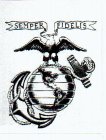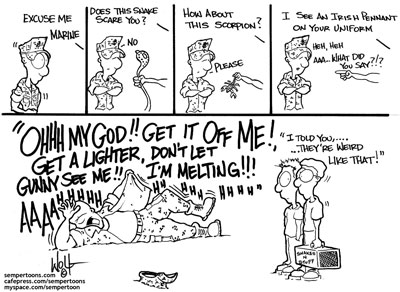 | ||
| August 2007 Newsletter | ||
In This Issue
Marine Corps History from the Month of August  The "Today in Marine Corps History" link from the TWS Home Page displays significant events of Marine Corps history. Below is a link to the events for the Month of August. The "Today in Marine Corps History" link from the TWS Home Page displays significant events of Marine Corps history. Below is a link to the events for the Month of August. Marine Corps History - The Month of August Military News
From the Desk of the Commandant  ALMAR 037/07 4th Marine Division Anniversary Message ALMAR 038/07 4th Marine Air Wing Anniversary Message MARADMIN 465/07 2008 Colonel Command Screening Board Results Member Submitted photos of the month The NCO Sword - Marines only  The Marine NCO Sword. The Non-Commissioned Officers of the Marine Corps have several distinctions of which they can be justly proud. They are the only noncommissioned officers in any branch of the regular United States Armed Forces who routinely have the privilege of carrying swords. (Certain units of the National Guard still authorize NCO swords for ceremonial use when wearing the distinctive uniform of the regiment). In addition, they have the unique position of being the only NCOs ever authorized to carry what is normally a commissioned officers weapon. The present day sword issued to the Non-Commissioned Officers of the Corps was originally adopted by the War Department on April 9, 1850, as the regulation saber for the foot officers of the infantry. In 1859, just prior to the Civil War, the Commissioned Officers of the Marine Corps had adopted the Model 1850 foot Officer's sword. They found it more serviceable than their lighter, Mameluke-type saber and particularly welcomed its leather scabbard which was not subject to the many dents their former brass scabbard had been forever acquiring in life aboard ship. Following the War between the States, the repeating military rifle made rapid developments. Dominating the battlefields of the world and sounding the death knell of the sword, the foot Officer's sword was looked upon as being more of an encumbrance than an asset in the field. Prodded by a desire to reinstate the traditional weapon of their predecessor, especially since its purpose had become more symbolic that utilitarian, Marine Officers reverted to their Mameluke sword in 1875 when the Corps entered its so-called "Golden Era". At this time, Marine Non-Commissioned Officers acquired the arm being given up by their Commissioned brothers-in-arms. Its this same weapon, with only minor alterations, which SNCOs of the Corps still carry in Marine parade formations. It was a gesture of considerable respect to the Marine Non-Commissioned Officers, for never before had a badge so symbolic of the Commissioned Officer been turned over to the Non-Commissioned ranks. At first glance, the Marine NCO sword in use from 1875 until 1934 was no different than the 1850 Officers model. Only the fish skin covering on the grip had been replaced by black leather and the letters "U.S.M.C" etched on the reverse side of the blade instead of "U.S.", which had appeared on the Officers arm. In 1934, revised regulations called for a slightly more slender blade which eliminated the narrow fuller. A new and decorative etching was inscribed, "United States Marines". Otherwise, it remained identical to the Civil War officers model, albeit a lighter, somewhat less serviceable version. The Commissioned and Non-Commissioned Officers now retain the sword for what it implies to their profession, rather than for the use that it offers. Their primary duty is to lead, not to shoot. The sword thus continues as the personification of military tradition and has been entrusted to those most responsible for maintaining the weapon. Except for the famous Mameluke hilted sword of Marine Commissioned Officers, the Marine NCO sword rates as the oldest U.S. weapon still in use. Source: Ken Carter via Seamus Garahay's All-Hands Network. Photo Source: http://www.usmcedge.com/issue.html NEW! TWS Jobs Board  Following considerable success on the TWS Navy site which in just 3 weeks has now over 200 positions listed, we have launched a comprehensive, categorized Job Board on Marines.TWS as well for the purpose of displaying positions which might be of interest to Marines who have left the service or will leave shortly. The Job Board, which is displayed on the left hand Home Page, is viewable only by TWS Marine Members and all jobs are posted by Members who are familiar with the credentials of US Marines. Latest Job Board postings are also featured in this newsletter (to over 100,000 members) as posted below. Translation, the TWS jobs board is an exceptional way to reach qualified, motivated Marines that are potentially your best employees. Following considerable success on the TWS Navy site which in just 3 weeks has now over 200 positions listed, we have launched a comprehensive, categorized Job Board on Marines.TWS as well for the purpose of displaying positions which might be of interest to Marines who have left the service or will leave shortly. The Job Board, which is displayed on the left hand Home Page, is viewable only by TWS Marine Members and all jobs are posted by Members who are familiar with the credentials of US Marines. Latest Job Board postings are also featured in this newsletter (to over 100,000 members) as posted below. Translation, the TWS jobs board is an exceptional way to reach qualified, motivated Marines that are potentially your best employees.If your company has any positions suited to Marines seeking employment, you are very welcome to post these on the Job Board. This is a FREE service to TWS subscribers Post a Job on TWS Currently Posted Positions TWS Window Stickers - Order Yours now You asked for them on the Forums and they're ready, TWS Window Stickers!  To keep it simple, they're only being offered for sale in packs of 3 for a flat cost of $10, which includes shipping. This first-run batch (which may be the only one) is of limited quantity so order yours now. Just send Cash, check or Money Order, payable to W.T.Prater, P.O. Box 50, Bryantsville, KY 40410. These are only being offered in quantities of 3, just to keep it simple, but you can order 6, 9, 12, as many as you want. Payment can also be made via PayPal to [email protected], please be sure to include your mailing address with the payment. Special thanks to Ken Foran for providing the artwork for these stickers. Cpl Ken Foran Member Comments "I want to thank everyone on this forum for the help I was given.Advice,names,numbers,etc.....My buddy Jerry Recore recieved a letter from the Department of the Navy yesterday informing him that he was awarded a Purple Heart Medal for being wia Feb.22nd 1967.It was in the early 1990's that I found out that he did not get his PH.It took over 15 years but we gott'r done. s-f, dlk." Sgt Dale Kremsreiter "This is an amazing web site. There is more infomation in here than one person can see in a lifetime. And well layed out" Capt Lionel Raymond "This website is a real joy. I don't think you could have any idea what happiness you have brought to so many people....or maybe you do. Anyway thank you very much. Semper Fi, Wes Martin 5803" Major Jonathan Martin "Sir: Thank you for the site, I'm still learning the navagation on it. Land nav was never my strong suite and neither is all the computer wizardry. However I've already heard from an old friend so it's damned well worth it!!" CWO2 Jesse Apodaca "I want to thank you for being apart of something like this and allowing others to enjoy this web site. already I find it to be the best thing out their. I am sure to invite other marines so they can be a part of this family of true pride and honor of being Marines. thank you once again" Sgt Kenneth Mendez Marine Corps Ball Season is fast approaching  If you're Looking to attend the Marine Corps Ball but don't know where one is, visit MyMarineCorpsBall.com, enter your zip code, and learn of about events available within a 150 mile radius. If you are a Ball Coordinator register here to manage and get organized for your ball and if you need party supplies, we've got that covered too. We've partnered with the Marine Corps Association and other vendors to support Marines and provide quality goods and services. Guest of Honor? If you are an E-6 or higher register now and "Opt-in" to be listed as a Guest Of Honor (GOH)! Ball Coordinators will be able to see your 'profile' (image and bio) and potentially select you as a Guest of Honor. TWS Fallen Marine Project  TWS is a place to honor the service history of all Marines who served including those who fell in combat. So that they will not be forgotten, we have created a special facility where any TWS Member can post a Remembrance Profile for a Fallen Marine they knew or would like to honor, and this can be accessed via the "Remember a Marine" link on the LH Home page. TWS is a place to honor the service history of all Marines who served including those who fell in combat. So that they will not be forgotten, we have created a special facility where any TWS Member can post a Remembrance Profile for a Fallen Marine they knew or would like to honor, and this can be accessed via the "Remember a Marine" link on the LH Home page.We have also introduced a new feature which will enable TWS Members to adopt the Profile of a Fallen Marine already posted to the site. TWS has researched and compiled comprehensive information on all 14,387 Marines who fell in the Vietnam War, 1965-1975, and these will be put in place imminently. As no one is currently assigned to maintain these Profiles, we invite TWS Members to adopt one or more Fallen Profiles for the purposes of posting any additional information and perform the role of custodian for that Profile. We will try to avoid uploading duplicate Remembrance Profiles for those which have already been posted by TWS Members. To adopt the Profile of a Fallen Marine from the Vietnam War, please click on the Adopt a Fallen Marine Profile link on the left hand Home Page after you log in or click here Global Incident Map If you want to know what is going on in the world of terrorism, threats, explosions, airline incidents, etc., keep this web page. It's not just about terrorism - it's about what is happening every day, every minute some place in the world that could affect all of us in some way. It updates every 30 seconds, constantly. You just click on any map icon for full info at any time. Global Incident Map Marine Corps Stuff - 232 Marine Corps Ball - Tun Tavern to Baghdad 232 Marine Corps Birthday Ball - Tun Tavern to Baghdad Celebrate the 232nd Marine Corps Birthday Ball with our men and women serving in Baghdad. TWS has teamed up with with Devil Dog Brew, CombatBet, MilitaryByOwner, and SemperToons to help the Marines celebrate while serving in Iraq. Every purchase of three (3) coffee items will receive a custom designed premium ceramic poker chip commemorating the 232nd Marine Corps Birthday Ball being celebrated by the Marines in Baghdad. A gift of Devil Dog Brew coffee and a poker chip will also be sent to honor our men and women in Baghdad! Free shipping is provided with any order of 3 or more coffee items! Click here to find out more. This is a limited time event, in order for us to make shipping deadlines to the Marines in Iraq this program is running through October 13, 2007. Complimentary Upgrade to Those Serving in OIF/OEF TWS is proud to provide 12 months complimentary Full Membership to any active serving TWS Member currently deployed in support of Operation Iraqi Freedom/Operation Enduring Freedom. Please let us know who you are, on the honor system, by e-mailing us at the address below. Please inform other Marines in your unit that they are also entitled to this complimentary upgrade when they join TWS. Semper Fi Marines, we're proud to call you "Brothers in Arms". Email: [email protected] From our Marine Humor Board Aunt Karen The teacher gave her fifth grade class an assignment: Get their parents to tell them a story with a moral at the end of it. The next day the kids came back and 1 by 1 began to tell their stories. "Johnny, do you have a story to share?" "Yes ma'am. My daddy told a story about my Aunt Karen. She was a Marine pilot in Desert Storm and her plane got hit. She had to bail out over enemy territory and all she had was a flask of whiskey, a pistol and a survival knife. She drank the whiskey on the way down so it wouldn't break and then her parachute landed right in the middle of twenty enemy troops. She shot fifteen of them with the gun until she ran out of bullets, killed four more with the knife, till the blade broke, and then she killed the last Iraqi with her bare hands." "Good Heavens" said the horrified teacher.?? What kind of moral did your daddy tell you from this horrible story?" "Stay the ___ away from Aunt Karen when she's drinking." Submitted by: SSgt Juan Garcia Give the Gift of Full Membership TWS is continuing the option for any Full Member to make a gift of Full Membership to another TWS Member by simply clicking on the "Upgrade to Full Membership" button on the Member's Profile Page. During the last month we have received several generous donations which has allowed us to upgrade all WW2 Marine Veterans to Lifetime Full Membership. We're proud to offer this facility to give the opportunity for Marines to support their Marine Brothers. Assisted Member Profile Form Marines from WW2 and ROK eras are becoming fewer in number and memories of their service are slowly being lost. Many Members have asked if we have a form that we could supply that will allow them to record the service details of these senior Marines who are unable to use a computer, or don't have access to one, and post their own Profile on TWS. This form will allow Members to post an "Assisted" profile for these Marines whose entire service will be honored on TWS, in words and photographs, for the benefit of their Family and future generations of Marines. An easy to complete Profile Completion form is available as a PDF file download from the TWS Home Page - "Remember a Marine" or by clicking here. Please consider to distribute these forms within your MCL Detachments or local VA hospital, for example, which may be completed by the Marines themselves. Please help preserve the legacy of those who served and post an Assisted Profile for a Marine. Technical Assistance The TWS profile pages are very detailed, so we've created a list of tips and pointers to help you navigate the site more easily. You may click on the "?" symbol at the top right of the book layout or follow this Link for assistance. Lost Your Password? If you have forgotten your User ID and Password you can be quickly and easily reminded by clicking on the "Reminder" link contained on the Login page or following this Link. Your Username and Password will be immediately sent to you by e-mail. Comments/Suggestions Please forward any comments or suggestions that you feel would further improve the website to [email protected] or just reply to this newsletter. Enjoyed This Newsletter? Please forward this on to any other Marines you know. As TWS grows so does its potential to find old buddies and new friends as well as creating a vibrant and enjoyable Marine Community representing all eras from WW2 to present day. |
Definition of a Veteran "A veteran - The "Brotherhood" in action Kudos to Bill David and crew for pulling together an extremely successful TWS Get Together and for honoring Medal of Honor Marine PFC Jack Lucas in the process! Buddies Found on TWS
 "I have found 4+ guys from boot and waiting to hear back from some others. also have found one of my DI's who is also a member of this site. I al now looking for guys I had served with and the list keeps growing. S/F, Sam" "I have found 4+ guys from boot and waiting to hear back from some others. also have found one of my DI's who is also a member of this site. I al now looking for guys I had served with and the list keeps growing. S/F, Sam"
Please help do your part to make TWS an even more powerful buddy-finder that will be of service by helping even more Marines find each other - Help spread the word about TWS by inviting other Marines to join! Marines in Combat - Iraq...Your Photos  "Clearing a Bridge" Operation Iraqi Freedom, 2007; submitted by Cpl Edwin Perez-Griffith  "On the Move", Operation Iraqi Freedom, 2003; submitted by GySgt Tony Murchison  "Walking the Streets of Ramadi after VBIED call", Operation Iraqi Freedom 4-6, 2005; submitted by MSgt Robert Takacs  "EPW Operations", Operation Iraqi 1; 2002; submitted by Cpl Kevin Johnson  "Doc Treating a local...", Operation Iraqi 1; 2002; submitted by Sgt Mark Fackler There are currently over 329,000 members submitted photos on TWS, a picture is worth a thousand words... Featured Upgrades This Month Member Blocking  If you change your mind you can unblock the member from the same place - or by visiting his/her profile and clicking the link in Outbox "Unblock Member":  At any time you can see how many members you have blocked from your inbox - just click the link to be reminded who they are:  Turn off Messaging  Today's Birthdays Reunions & Get Togethers Big Smoke Las Vegas The TWS Reunion Board has a wealth of info on pending reunions, updated constantly by coordinators, etc. Liberty Call - Visit the Grand Canyon Skywalk Visit the Grand Canyon Skywalk Weapons Board - The Ka-Bar USMC Fighting Knife
Cyber Corner: Website of Interest - AnyMarine.com AnyMarine.com Grass Roots organization that began in 2003 has grown to a very powerful tool for supporting deployed Marines (all service members). Click the above link for more information, or click here for their press release. TWS Invite Cards - Free for the asking Pre-printed TWS invitation cards are available and free to any member. These are the perfect tool for you to use to help Spread The Word about TWS to any and all Marines you come into contact with, and they're a great conversation starter! It's the perfect way to get to know those Marines in your community.  "I was having a bad morning back in the winter...apparently my brake line had water in it and it froze, so I couldn't move my car (yes, this is relevant to the topic). So, by the time I dumped enough hot water on it to get it thawed out, I was about 45 minutes late in getting to the FedEx Office to pick up a part and get to the site for the down machine I was working on. Trade Banner Links with TWS  If you operate a Marine orientated website and are willing to trade links with TWS, click here for information on posting a TWS banner on your site. In return, please contact us at [email protected] with your site's URL, up to 100 words describing your website and a 468x60 website banner in jpeg format, if available. We'll be happy to post a reciprocal link in our Preferred Marine Links Section in the category of your choice. TWS Marine Links Pages are conveniently organized under different categories including Marine Associations, MCL Detachments, Marine Businesses, Marine Charities and others. Videos This Month Interesting little Rifle - and cheap to shoot! Appears to be a .22 cal automatic of some sort. Sourc unknown, but makes you want one! Interesting little Rifle One for the aviators, you may not believe this one. Source: Sonnyradio.com - History Channel video. F-15 landing YouTube Video of the month... SemperToon of the Month Changes to Marine Corps Uniform and Grooming Regulations
Sincerely, |
|
Copyright © 2003-2007 TogetherWeServed | All Rights Reserved. |
||






 "I've found a total of 5 - 2 guys from my graduating platoon 2085/H (1985); 1 former Bn. SgtMaj. (1987-89); 2 marines I served with in Okinawa, Japan (Camp Hansen 1986-87)"
"I've found a total of 5 - 2 guys from my graduating platoon 2085/H (1985); 1 former Bn. SgtMaj. (1987-89); 2 marines I served with in Okinawa, Japan (Camp Hansen 1986-87)" "..Met Jim Kisor at the hardware store who is a member here, We live just a couple of miles apart and never met or knew about each other until I saw his EGA decal on the car window and started talking. THAT WAS COOL!"
"..Met Jim Kisor at the hardware store who is a member here, We live just a couple of miles apart and never met or knew about each other until I saw his EGA decal on the car window and started talking. THAT WAS COOL!" "[I found] SSgt F.L. Bear (USMC/Ret) - SSgt, MOS-0141. There's a Floyd L. Bear, born in 1931, Sierra Vista, AZ...George Reilly did it!!! This is my JDI. How do I know? I just called him and we had a GREAT conversation! Thank you George! Floyd is going to go to my website and check my PI page and we plan on staying in contact. He was on Okinawa when I was, went to RVN and retired on 20 -- and so did his son.I would never have thought I would speak to this man again and you guys made it possible! Thank you!"
"[I found] SSgt F.L. Bear (USMC/Ret) - SSgt, MOS-0141. There's a Floyd L. Bear, born in 1931, Sierra Vista, AZ...George Reilly did it!!! This is my JDI. How do I know? I just called him and we had a GREAT conversation! Thank you George! Floyd is going to go to my website and check my PI page and we plan on staying in contact. He was on Okinawa when I was, went to RVN and retired on 20 -- and so did his son.I would never have thought I would speak to this man again and you guys made it possible! Thank you!"



